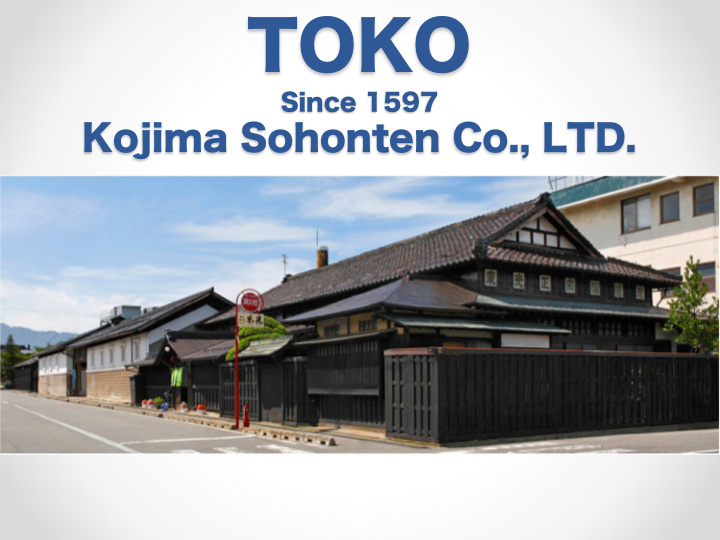



TOKO Since 1597 Kojima Sohonten Co., LTD.
Location Yonezawa city, Yamagata prefecture. Northeastern area in Japan. � ��������
Climate One of the most snowy area in Japan. Annual snow accumulation is 6m! (3.3ft) Kojima Sohonten in Winter
among about 1,500 ones. The 11 th oldest sake brewery Founded in Company Name Location 1141 Sudo Honke Ibaraki 1487 Hiraizumi Honpo Akita 1505 Kenbishi Shuzo Hyogo 1532 Yamaji Shuzo Shiga 1548 Yoshinogawa Shuzo Niigata 1550 Konishi Shuzo Hyogo 1555 Chino Shuzo Nagano 1592 Haneda Shuzo Yamagata 1596 Koya Shuzo Yamagata 1596 Toshimaya Honten Tokyo 1597 Kojima Sohonten Yamagata 1602 Yomeishu Seizo Tokyo http://allabout.co.jp/gm/gc/225336/2/
In operation shince 1597. Purveyor to the lord of Yonezawa. We were unusually permitted to brew Sake for the lord and Kami (spirit of Shinto) even under prohibition ordinance in the famine. Founding lord Kenshin Uesugi Uesugi Shrine (Ruins of Yonezawa catsle)
Origin of “TOKO” 東(TO) means EAST, 光(KO) means LIGHT. TOKO is “Sake brewed on east side of catsle, the direction of sunrise”. Kojima Sohonten � Yonezawa Catsle
Alluvial fan delivers soft melted water from headwaters of Mogami river TOKO Yonezawa Yonezawa Station Catsle � � � Alluvial fan Headwaters of Mogami river �
Contract farming Farmers cultivate Sake Rice for TOKO, and they brew Sake in the brewery during winter.
Installation of washing soaking system Installing up-to-date equipment helps us to get both of delicateness and umami, for all of production of 650,000 bottles an year (720ml).
Pressing in refrigerator All the batches are pressed in refrigerator to keep freshness
recycling-oriented production Rice bran is used for organic fertilizer and rice cracker. Bottling Washing Moromi Shubo Rice Rice Pressing & & (Main Cultivating Polishing (Starter) Soaking fermentation) Pasteurizing 100% Polishing rate Polishing rate Polishing rate Polishing rate Polishing rate (Brown Rice) 90% 60% 50% 40% 35% Brown Bran Organic fertilizer White Bran Rice Cracker
recycling-oriented production spirits, and organic fertilizer. Sake lees of TOKO are used for pickles, cooking, Bottling Washing Moromi Shubo Rice Rice Pressing & & (Main Cultivating Polishing (Starter) Soaking fermentation) Pasteurizing Pickles of vegetable Pickles of fish (for grill) Taking off Sake lees Spirits Organic fertilizer
AWARDS Ginjo Daiginjo Trophy of International Wine Challenge 2014.(First prize in Daiginjo division) TOKO Daiginjo Yamadanishiki won IWC 2014 Ginjo Daiginjo Trophy
AWARDS Won top awards and gold medals, from several competitions. TOKO Junmaidaiginjo TOKO Junmaiginjo TOKO Junmai Drip Sake Genshu International Fine Sake Award Fine Sake Award Sake Challenge 2016 2018 2018 Gold Medal Gold Medal Gold Medal
Classification of Sake
More recommend